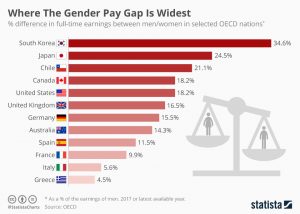HRM and The Law
As described in the previous section, the society in which we live is constantly evolving. As the values that we share collectively change, so do the rules and regulations that we impose on ourselves. The legislative framework that is adopted by governments is a reflection of our values. For the HR manager, a clear understanding of the legal framework is absolutely necessary.
The Legal Framework
Federal Human Rights Laws
The Canadian Charter of Rights and Freedoms
The Canadian Human Rights Act (CHRA)
- “All individuals should have opportunity equal with other individuals to make for themselves the lives that they are able and wish to have”: this means that, considering their desires and abilities, the opportunity to earn a living, which implies the ‘opportunity to work’, should be equal for all.
- These opportunities should not be hindered by discriminatory practices based on “race, national or ethnic origin, colour, religion, age, sex, sexual orientation, gender identity or expression, marital status, family status, genetic characteristics, disability or conviction for an offence for which a pardon has been granted or in respect of which a record suspension has been ordered”: the CHRA is very specific as to the categories that are deemed discriminatory. These categories have changed over time, following changes in our society. Currently, the issues raised by genetic testing are at the forefront of these societal changes. Is it legal to deny insurance for people known to have gene mutation that causes or increases the risk of an inherited disorder? These issues are currently being debated (see Canadian Supreme Court decision) and as genetic testing becomes more common, we as a society, will have to decide the extent to which it is OK to use this information to make decisions about people.
Enforcement of CHRA
The CHRA only applies to federal government departments and agencies, to Crown corporations, and to businesses under federal jurisdictions such as banks, airlines, and communication companies. Employees of these organizations who feel discriminated against can file complaints directly to the Canadian Human Rights Commission (CHRC). There is a systematic process in place to handle these complaints. After a complaint is filed, a mediation process is attempted to try to resolve the issue between the parties. If the mediation fails, the dossier is handed over to the Human Rights Commissioner who can decide to:
- dismiss the complaint;
- send the complaint to conciliation;
- defer the decision and request more information and further analysis; or
- refer the complaint to the Canadian Human Rights Tribunal
Pay Equity
Over the years, the Canadian (Federal) and Provincial governments have enacted various forms of legislation and statutory mechanisms to specifically address the issue of gender wage discrimination (see graph).
According to Forbes, Canada had a 18.2% pay disparity between men and women.

Video:
The Federal Pay Equity Act came into force on 31 August 2021. As of this date, all employers with 10 or more employees must proactively address pay equity issues within their organizations. The goal is to ensure that there is pay equity between employees that are in position commonly held by women with those that commonly held by men.
The Canadian Government reported that in 2020 that women in Canada, on average, earn 89 cents for every dollar earned by men.
Average and median gender wage ratio, annual (statcan.gc.ca)
Employment Equity Act
The Employment Equity Act is federal legislation that serves to enable equality in the workplace by addressing the barriers to employment as faced by members of the four designated groups:
- Women
- Aboriginal peoples
- Persons with disabilities
- Visible minorities
Provincial Human Rights Laws
Guide to your rights and responsibilities under the Human Rights Code (ohrc.on.ca)
The Ontario Human Rights Code provides protection from discrimination. The Code states that every person has a right to freedom from discrimination in five social areas:
- Services, Goods and Facilities
- Housing
- Contracts
- Employment
- Membership in Vocational Associations and Trade Unions
The Code also specifies the prohibited grounds of discrimination:
- Age
- Ancestry
- Citizenship
- Colour
- Creed
- Disability:
- disability as a medical condition that a person has.
- barriers that prevent every member of society from participating fully
- Ethnic origin
- Family status
- Gender expression
- Gender identity
- Marital status
- Place of origin
- Race
- Receipt of public assistance
- Record of offences
- Sex
- Sexual orientation
It is important to stress the fact that these protections are not universal and that they reflect the society that they are intended to influence. In the US for example, many protections that are considered basic in Canada have been challenged in court. For example, the Supreme Court recently upheld a decision that protects LGBTQ workers from discrimination by a 6-3 margin.
Enforcement of Provincial human rights laws
Employees of those organizations that fall under the Ontario Human Rights Code who feel discriminated against can file complaints directly to the Human Rights Tribunal of Ontario (HRTO). The complaint can be handled either by mediation or a hearing.
Videos:
Indigenous Perspective
In addition to the Employment Equity Act, there are specific legislation that apply to the First Nations communities that are important for HR professional to be aware of including:
And
While it is acknowledged that the term Aboriginal may not adequately reflect or represent the diversity of the indigenous communities, for the purposes of the Employment Equity Act, Aboriginal peoples is used to reflect the terminology in the Act itself.

